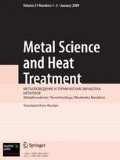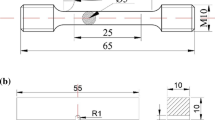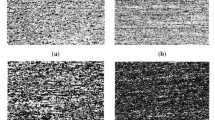Conclusions
-
1.
The dependence of the impact toughness of high manganese steel on its carbon and manganese content makes it possible to evaluate the effect of their absolute and relative amounts which is decisive for obtaining the maximum level of impact toughness. with equal ratio Mn:C manganese affects impact toughness more than carbon.
-
2.
It is not recommended to evaluate impact toughness only by the relative manganese and carbon content of steel. In establishing the effect of the ratio Mn:C the absolute manganese and carbon content has to be taken into account. Maximum impact toughness of steel 110G13L can be attained with the ratio Mn:C=16; however, then the carbon content within the limits of the brand composition has to be minimal, and the manganese content maximal.
-
3.
High levels of impact toughness correspond to the formation of a pitted microrelief and surfaces of ductile lamination in the structure of the fracture. With decreasing level of impact toughness the size of the pits decreases. Minimum impact toughness is characterized by a microfracture with disperse pitted structure, the precipitation of a considerable amount of nonmetallic phase, and the existence of sections of intergranular and quasibrittle failure.
Similar content being viewed by others
Literature cited
V. I. Vlasov and E. F. Komolova, Cast High Manganese Steel [in Russian], Mashgiz, Moscow (1963).
R. Z. Kats and M. S. Mikhalev, "The manganese content of steel G13L," Liteinoe Proizvod., No. 6, 46 (1967).
Yu. A. Nekhendzi, Steel Casting [in Russian], Metallurgizdat, Moscow (1948).
E. Goudremont, Special Steels [Russian translation], Vol. 1, Metallurgiya, Moscow (1966).
G. Knyaginin, "Letter to the editor," Liteinoe Proizvod., No. 8, 49 (1967).
D. S. Kostinskii, "The ratio of manganese and carbon content of steel G13L," Liteinoe Proizvod., No. 10, 45–46 (1965).
M. P. Anidalov, "Factors determining the choice of steel replacing G13L in track links," Liteinoe Proizvod., No. 4, 1–3 (1964).
N. G. Davydov, High Manganese Steel [in Russian], Metallurgiya, Moscow (1979).
Additional information
Institute of Foundry Practice, Academy of Sciences of the Ukrainian SSR. E. O. Paton Institute of Electric Welding. Translated from Metallovedenie i Termicheskaya Obrabotka Metallov, No. 4, pp. 18–22, April, 1986.
Rights and permissions
About this article
Cite this article
Kondratyuk, S.E., Vinokur, B.B., Lutsenko, G.G. et al. Ratio Mn:C and impact toughness of high manganese steel. Met Sci Heat Treat 28, 251–255 (1986). https://doi.org/10.1007/BF00707649
Issue Date:
DOI: https://doi.org/10.1007/BF00707649




